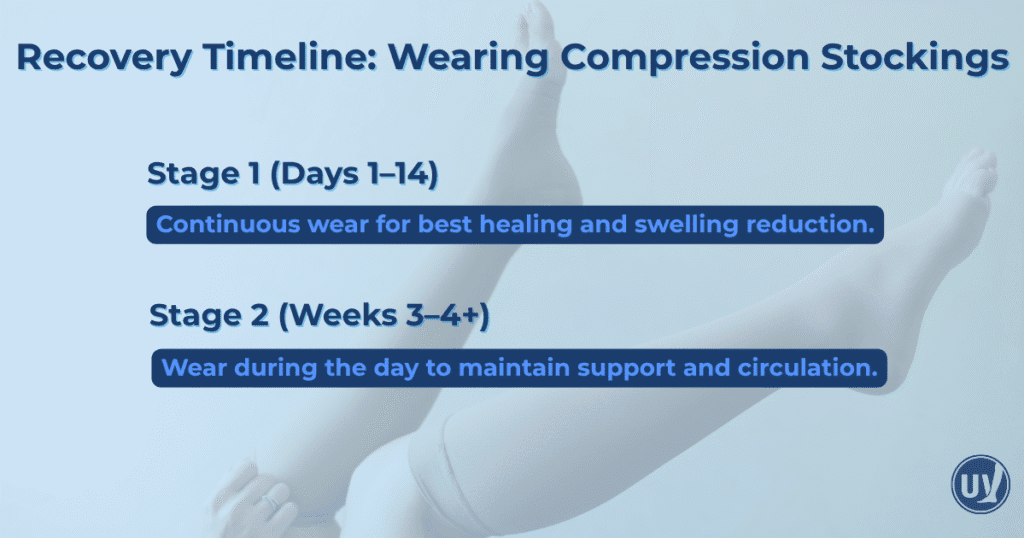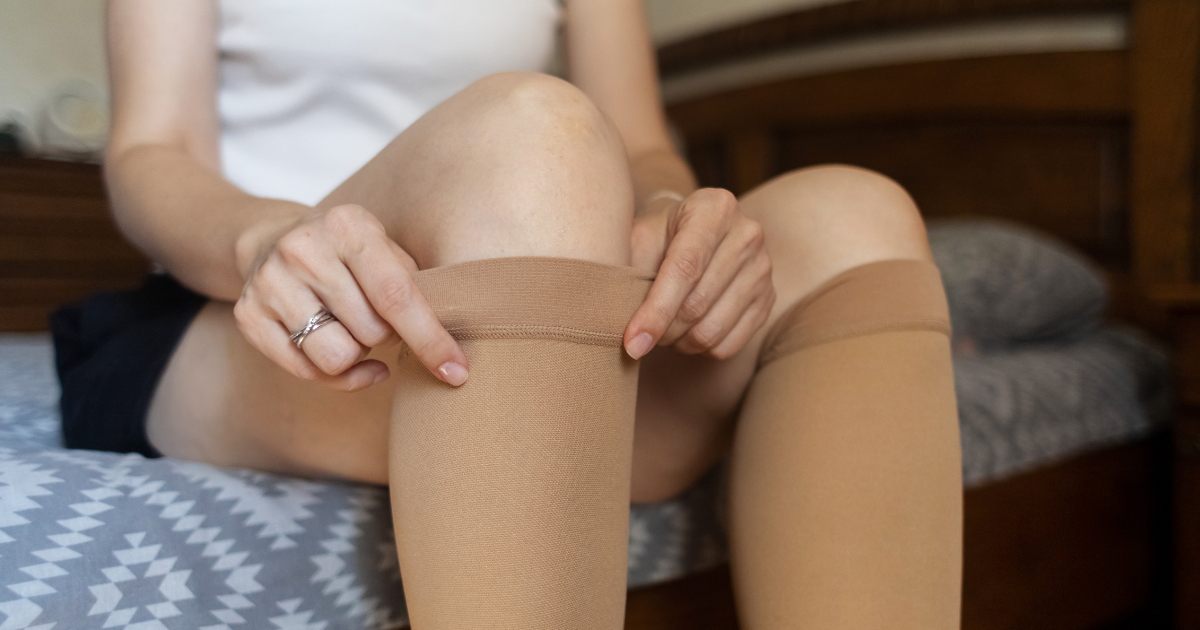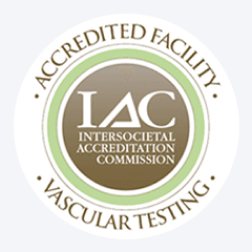Contents
- Why Compression Stockings Are Essential After Vein Procedures
- How Compression Therapy Supports Vein Procedure Recovery
- Recommended Duration for Wearing Compression Stockings After Different Vein Procedures
- How to Choose the Right Recovery Stockings
- Tips for Wearing and Caring for Post-Surgery Stockings
- What to Expect: Comfort, Fit, and Common Concerns
- When to Stop Wearing Compression Stockings and Signs to Watch For
- Maximizing Your Vein Procedure Recovery
- Frequently Asked Questions
Compression stockings are an essential part of recovery following vein procedures. They help boost blood flow, reduce swelling, and support the healing process. Wearing them correctly can also lower the risk of complications such as blood clots and speed up overall recovery.
The length of time you need to wear compression stockings depends on the type of procedure you had. Most patients wear them continuously for the first one to two weeks, then during the day for several additional weeks. Selecting the right level of compression is important and should always be guided by a healthcare professional. Understanding how and when to use compression stockings can make your recovery smoother, more comfortable, and more effective.
Why Compression Stockings Are Essential After Vein Procedures
Compression stockings play a critical role in vein procedure recovery. They help maintain proper blood flow and minimize swelling. Proper circulation is key to a smooth recovery process.
Wearing these stockings can significantly lower the risk of blood clots. This is essential as blood clots can lead to serious complications. Improved circulation also reduces discomfort and pain post-surgery.
Compression therapy aids in reducing bruising and supports vein healing. It acts by gently squeezing the legs, ensuring veins are under less stress. Better blood flow accelerates tissue recovery.
In conclusion, compression stockings are a vital part of recovery. Their role in post-surgery care cannot be overstated. They help you get back to your daily routine faster and safer.
How Compression Therapy Supports Vein Procedure Recovery
Compression therapy is integral for those undergoing vein procedures. It aids in faster and smoother recovery. By applying consistent pressure, it minimizes swelling and discomfort.
The key function of compression therapy is promoting healthy blood flow. This is crucial post-surgery as it supports the healing process. Improved circulation prevents complications like deep vein thrombosis.
Beyond physical benefits, compression therapy can enhance patient outcomes. It helps reduce post-operative symptoms such as leg heaviness. Moreover, it reassures patients, encouraging adherence to recovery guidelines.
Overall, compression therapy offers a comprehensive approach to healing. It supports the body in repairing and rejuvenating after vein procedures. As a result, patients often experience more effective and quicker recoveries.
Recommended Duration for Wearing Compression Stockings After Different Vein Procedures
The duration for wearing compression stockings varies with the type of vein procedure. Each procedure has specific recovery needs and recommendations.
Typically, most patients should wear the stockings for at least 1-2 weeks continuously. This period is crucial for initiating healing and promoting circulation.
After the initial phase, wearing them during the daytime for an additional 2-4 weeks is recommended. This continued use aids in reducing swelling and improving outcomes.
Healthcare providers typically provide personalized guidance. They take into account the patient’s health and the procedure performed.
Considerations include the severity of the vein problem and individual health conditions. It’s essential to closely follow medical advice to ensure effective recovery.
In summary, wearing duration can be outlined as follows:
- RFA: Continuous for 1-2 weeks, then daytime use for 2-4 weeks
- Sclerotherapy: Wear for 1 week, then as advised by the doctor
- Vein Ligation and Stripping: Usually requires longer use, up to 6 weeks during the day
Endovenous Laser Therapy (EVLT) and Radiofrequency Ablation (RFA)
For EVLT and RFA procedures, initial recovery is crucial. Patients should wear compression stockings continuously for the first 1-2 weeks post-procedure. This helps prevent clotting and reduces swelling effectively.
After the initial phase, using recovery stockings during the day for another 2-4 weeks is advised. This ongoing use supports further healing. Gradually, patients may reduce wearing time as their doctor recommends.
Sclerotherapy
Sclerotherapy typically requires a shorter recovery period. After the treatment, patients should wear compression stockings for the first week. This immediate use aids in sealing treated veins and minimizes bruising.
During follow-up visits, your vein specialist will assess progress. Based on the recovery, adjustments to wearing time may be made. The goal is to ensure effective vein closure and prevent complications.
Vein Ligation and Stripping
Vein ligation and stripping generally necessitate longer use of compression stockings. Patients are advised to wear them continuously for 1-2 weeks. This helps manage post-surgical symptoms like swelling and pain.
Daytime use should continue for up to 6 weeks as healing progresses. Consistent wear ensures support and enhances circulation during recovery. The duration can be adjusted based on patient progress and comfort level.

How to Choose the Right Recovery Stockings
Selecting the right recovery stockings is vital for effective compression therapy. The proper fit ensures comfort and maximizes benefits. Ill-fitting stockings can cause discomfort and be ineffective.
Consider several factors when choosing your stockings. These include the compression level, style, and material. Consulting with a healthcare professional is important for guidance on the appropriate compression level.
Compression stockings come in various styles and materials. Your choice depends on your daily needs and preferences. Some patients prefer knee-high, while others might need thigh-high support.
By following these steps, you can choose stockings that support your recovery effectively.
Tips for Wearing and Caring for Post-Surgery Stockings
Proper use and care of post-surgery stockings ensure they function effectively and last longer. Following the correct steps can help you avoid common issues like discomfort or improper compression.
When putting on your compression stockings, do so in the morning. Your legs are less swollen, making it easier to fit them correctly. Ensure no wrinkles as they can cause uneven pressure.
Taking off your stockings before bed allows your skin to breathe overnight. This reduces irritation and provides a break for your skin from constant pressure.
Caring for your stockings involves regular washing to maintain elasticity and hygiene. Hand washing in lukewarm water with a gentle detergent is best. Avoid using bleach or fabric softeners, which can damage the material.
By following these guidelines, you can make the most of your post-surgery stockings, supporting a successful recovery.
What to Expect: Comfort, Fit, and Common Concerns
Wearing compression stockings can initially feel strange. Some patients describe an unusual snug feeling. It’s important to remember that this sensation is normal and typically eases within a few days as your legs adjust.
Proper fit is crucial for comfort and effectiveness. If your stockings feel too tight or loose, consult your doctor. Ill-fitting stockings can cause discomfort and may not provide the necessary support.
Common concerns include skin irritation or pinching at the top band. Moisturize your legs regularly to maintain skin health and ensure stockings stay in place without digging into your skin.
Addressing these concerns can improve your experience, making compression therapy a supportive part of your vein procedure recovery.
When to Stop Wearing Compression Stockings and Signs to Watch For
The decision to stop wearing compression stockings depends on your individual recovery. Consult your doctor for personalized advice. Typically, patients wear them for several weeks post-procedure.
Watch for specific signs to guide your decision. A reduction in swelling, improved circulation, and decreased discomfort might indicate it’s time to phase out their use. However, any sudden increase in swelling or pain should prompt a discussion with your healthcare provider.
Key signs to monitor:
- Decreased swelling
- Improved circulation
- Reduced discomfort
Always prioritize your doctor’s guidance. Personalized medical advice is vital for optimal vein procedure recovery and health.
Maximizing Your Vein Procedure Recovery
Compression stockings play a vital role in recovery after vein procedures. They support healing, enhance comfort, and help prevent complications. Following your healthcare provider’s instructions ensures a smoother recovery and better long-term results. Proper care, adherence to recommended timelines, and monitoring for any changes can significantly improve outcomes.
If you have questions or concerns during your recovery, reach out to your medical team promptly. For personalized guidance and support, schedule a consultation with United Vein & Vascular Centers today. Our experienced team is here to help you achieve the best possible results and maintain healthy veins for years to come.
Frequently Asked Questions
Generally, it is recommended to wear them all day and remove them at night. However, follow your doctor’s specific instructions for optimal results.
Ensure they fit properly. Compression stockings should be snug, not tight or painful. Consult your healthcare provider if discomfort persists.
Yes, most compression stockings can be removed briefly for bathing or showering. It is important to put them back on immediately afterward to maintain consistent support and promote proper blood flow during your recovery. Always follow your healthcare provider’s specific instructions.


